
Mythimna ferrago, the clay, is a moth of the family Noctuidae. The species was first described by Johan Christian Fabricius in 1787. It is distributed throughout Europe and is also found in Morocco, Algeria, Turkey, Asia Minor, Armenia, Syria, Turkestan, Israel, Lebanon, Iraq, Iran, Central Asia and the western parts of temperate North Asia. Also Tibet.

The straw underwing is a species of moth in the family Noctuidae. The species was first described by Johann Siegfried Hufnagel in 1766. It is found from North Africa west through South Europe and Central Europe. In the north it is in parts of Ireland, Scotland, Sweden, Norway, Finland and Estonia. Further east the range stretches from southern Russia and Asia minor to the Caucasus.

Apamea crenata, known as the clouded-bordered brindle, is a moth in the family Noctuidae. It is distributed throughout the Palearctic realm. In the North it crosses the Arctic Circle, in the Mediterranean it is found only in cool locations and mountains avoiding very hot areas. In the Alps, it rises to an altitude of about 2000 metres.

Mythimna albipuncta, the white-point, is a moth of the family Noctuidae. The species was first described by Michael Denis and Ignaz Schiffermüller in 1775. It is distributed throughout Europe and one subspecies is found in Tunisia. It is also found in Asia Minor, Armenia, and Iran, and the northeastern United States.

Mythimna vitellina, the delicate, is a moth of the family Noctuidae. The species was first described by Jacob Hübner in 1808. It is mainly distributed throughout southern Europe and the southern part of eastern Europe. It is also found far less commonly further north in Europe. Also in North Africa, the Near East and Middle East, Central Asia and western China.

Globia sparganii, or Webb's wainscot, is a moth of the family Noctuidae. The species was first described by Eugenius Johann Christoph Esper in 1790. It is found in Europe, Central Asia, from southern Siberia to Manchuria, Korea, Turkey, Syria and Iran.

Atethmia centrago, the centre-barred sallow, is a moth of the family Noctuidae. The species was first described by Adrian Hardy Haworth in 1809. It is found in Europe except Scandinavia and Italy; also in Asia Minor, Armenia, Syria and Palestine.

Heliothis peltigera, also known as the bordered straw, is a species of moth of the family Noctuidae.
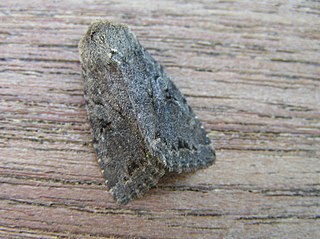
Fissipunctia ypsillon, the dingy shears, is a species of moth of the family Noctuidae. It is found in the Palearctic realm.

Xanthia togata, the pink-barred sallow, is a species of moth of the family Noctuidae. It is a Holarctic species, and is found throughout Europe and east through the Palearctic to Central Asia, and Siberia up to the Ussuri. The distribution area includes the United States and Canada. It was first described by the German entomologist Eugenius Johann Christoph Esper in 1788 from the type specimen in Germany
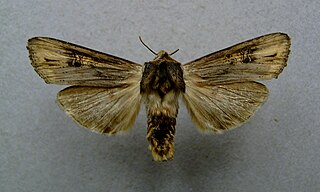
Xylena exsoleta, the sword-grass, is a species of moth of the family Noctuidae.

Polia bombycina is a moth of the family Noctuidae. It is found in the Palearctic realm from Ireland to Japan including the Russian Far East and Siberia.

Conistra rubiginea, the dotted chestnut, is a moth of the family Noctuidae. The species was first described by Michael Denis and Ignaz Schiffermüller in 1775. It is distributed in Europe and, according to William Warren, Armenia and Asia Minor.

Mythimna turca, the double line, is a moth of the family Noctuidae. The species was first described by Carl Linnaeus in 1761. It is found in Europe. The eastern expansion extends through northern Asia and central Asia to northern China, Korea and Japan. It rises to a height of about 700 metres in the Alps.
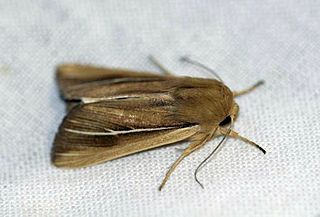
Mythimna litoralis, the shore wainscot, is a moth of the family Noctuidae.

Mesapamea secalis, the common rustic, is a moth of the family Noctuidae. The species was first described by Carl Linnaeus in his 1758 10th edition of Systema Naturae. It is found in Europe, north-west Africa, Turkey and northern Iran.

Agrotis trux, the crescent dart, is a moth of the family Noctuidae. The species was first described by Jacob Hübner in 1824. It has a circum-Mediterranean distribution and is found along the coasts of France, Ireland, England, southern Europe, Algeria, Syria, Iraq, Iran, southern Russia and the Arabian Peninsula. In Africa, it is found as far south as South Africa.

Jodia croceago, the orange upperwing, is a moth of the family Noctuidae. The species was first described by Michael Denis and Ignaz Schiffermüller in 1775. It is found in southern and central Europe, to the north up to the southern half of England and Wales. According to Warren. W. in Seitz, A. Ed., 1914 also in Algeria, Asia Minor, and Armenia.
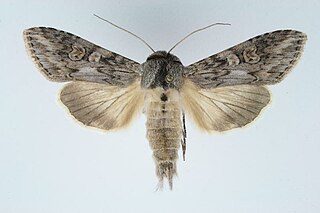
Cucullia artemisiae, or scarce wormwood, is a moth of the family Noctuidae. The species was first described by Johann Siegfried Hufnagel in 1766. It is found from central and southern Europe to Turkey and across the Palearctic to western Siberia, Central Asia, Manchuria, the Korean Peninsula and Japan.
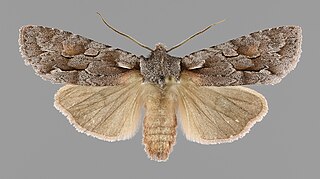
Lithophane lamda, the nonconformist, is a moth of the family Noctuidae. It is found throughout Europe, except in southern Europe. It is also absent from Iceland and Ireland.






















